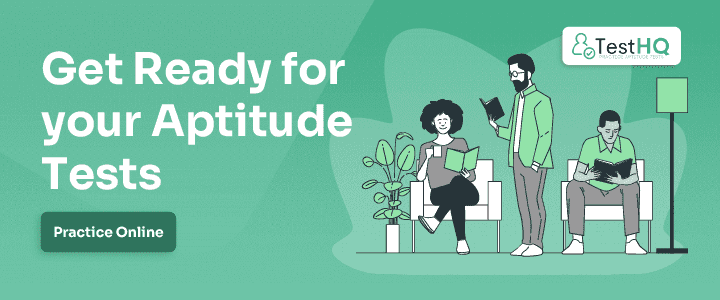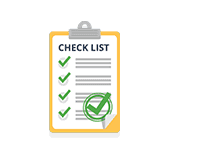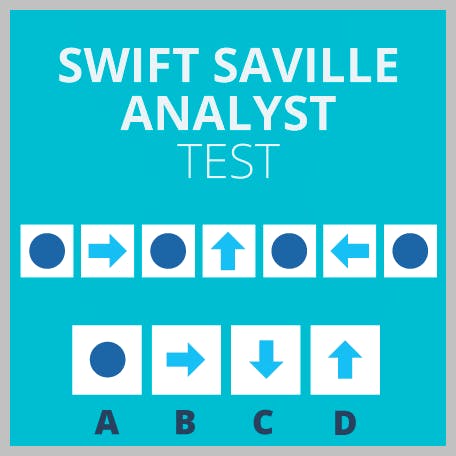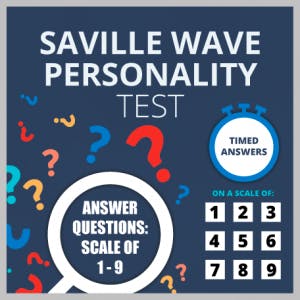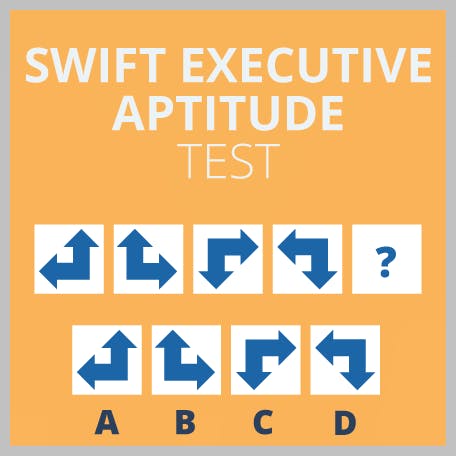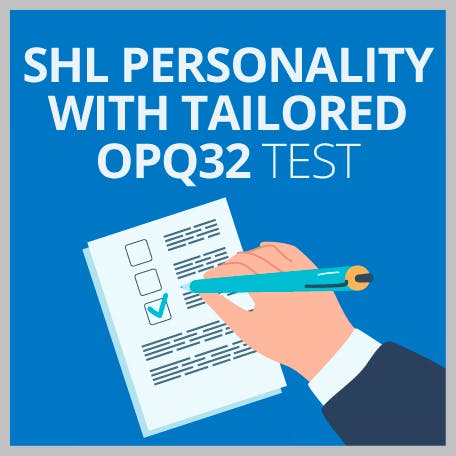Swift Executive Aptitude Test
Updated May 31, 2024
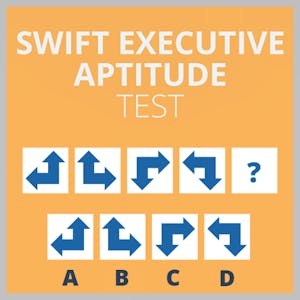

If you are applying for an executive-level or management role, you might be expected to take an aptitude test as part of the recruitment process.
The Swift Executive Aptitude Test is a short assessment designed to measure specific aptitudes that are necessary for success in a leadership position.
In this article, you will discover more about the test, the structure of the assessment, and example questions.
You will also learn what you will need to bear in mind to be successful in the test, including tips about preparation and a breakdown of what to expect from the scoring.
What Is the Swift Executive Aptitude Test?
Designed by Saville Assessments, the Swift Executive Aptitude Test is part of a battery of workplace assessments that are based on more than 15 years of psychological research.
Saville Assessments have used first-hand knowledge about what predicts potential and performance to create the assessments, which can be tailored to fit any business.
Saville Assessments are used around the world, in global conglomerates and smaller businesses alike, for recruitment, development and talent management.
Companies that use the Saville Assessment suite, including the Swift Executive Aptitude Test, include:
- Fujitsu
- BNP Paribas
- Jaguar Land Rover
- NHS
- BP
- Virgin Media
You will need to take the Swift Executive Aptitude Test if you have applied for a leadership or executive role, and in some cases for any type of management role.
It is designed to assess the specific skills that you will need and your aptitude for leading people and dealing with the pressures of an executive-level job.
The test itself is usually taken online, lasting just 18 minutes, and covering three different aptitude areas in 24 questions.
The areas that are evaluated are:
- Verbal Ability
- Numerical Ability
- Abstract Ability
The 3 Sections of the Saville Swift Executive Aptitude Test
1. Verbal Analysis
The first section of the Swift Executive Aptitude Test is the Verbal Analysis section, which looks specifically at verbal ability and how you process information that is presented in a written format.
In this section of the assessment, you will have six minutes to answer eight questions. Each question is based on a paragraph of information, with multiple choice answers.
You do not need any previous knowledge of the business or the role you have applied for to answer this question, as all the details needed to find the correct answer from the multiple-choice options will be in the written data.
There are several different reasons given for the poor performance of the football team. Firstly, the manager does not seem to have a vision for the team and instead continues to rely on previous ideas that haven’t worked.
The Board appears to have withdrawn most of the funding, and with that, the chance of signing any new talent is dwindling. And finally, the fans seem to be losing confidence that the team is going to bounce back at all.
Who is responsible for the lack of funding in the team?
a) The players
b) The manager
c) The fans
d) The Board
2. Numerical Analysis
In the Numerical Analysis section, you will be presented with a number of mathematical questions based on your understanding of a series of tables, graphs or charts.
You will have eight questions to answer in just six minutes and will be expected to use basic mathematical operations like multiplication, addition, division and subtraction, as well as a working knowledge of percentages, fractions and ratios.
The numerical ability questions are also multiple-choice, which does make it easier for you to ensure that your math thinking is going the right way when you are answering the questions.
| Name | Grade | Expected Grade |
|---|---|---|
| Davis | 3.4 | 5.2 |
| Graham | 2.5 | 3.2 |
| Andrews | 3.2 | 5.2 |
| James | 2.8 | 4.9 |
In the table above, which student is predicted to have the biggest difference between their current grade and their expected grade?
a) Davis
b) Graham
c) James
d) Andrews
3. Abstract Reasoning
The abstract reasoning section of the test is likely to be the most complex for most test-takers because it is something a bit different for those who have never taken a psychometric test before.
Abstract reasoning is assessed by pattern recognition and prediction, using limited data to find a logical answer.
In the abstract reasoning test, you are provided with a series of shapes or images in a sequence that is governed by a rule.
In the pattern will be a missing item, and you will need to choose the item that is missing from the multiple-choice options.
In this section of the test, you will have six minutes to answer eight questions.
Which comes next in the sequence?
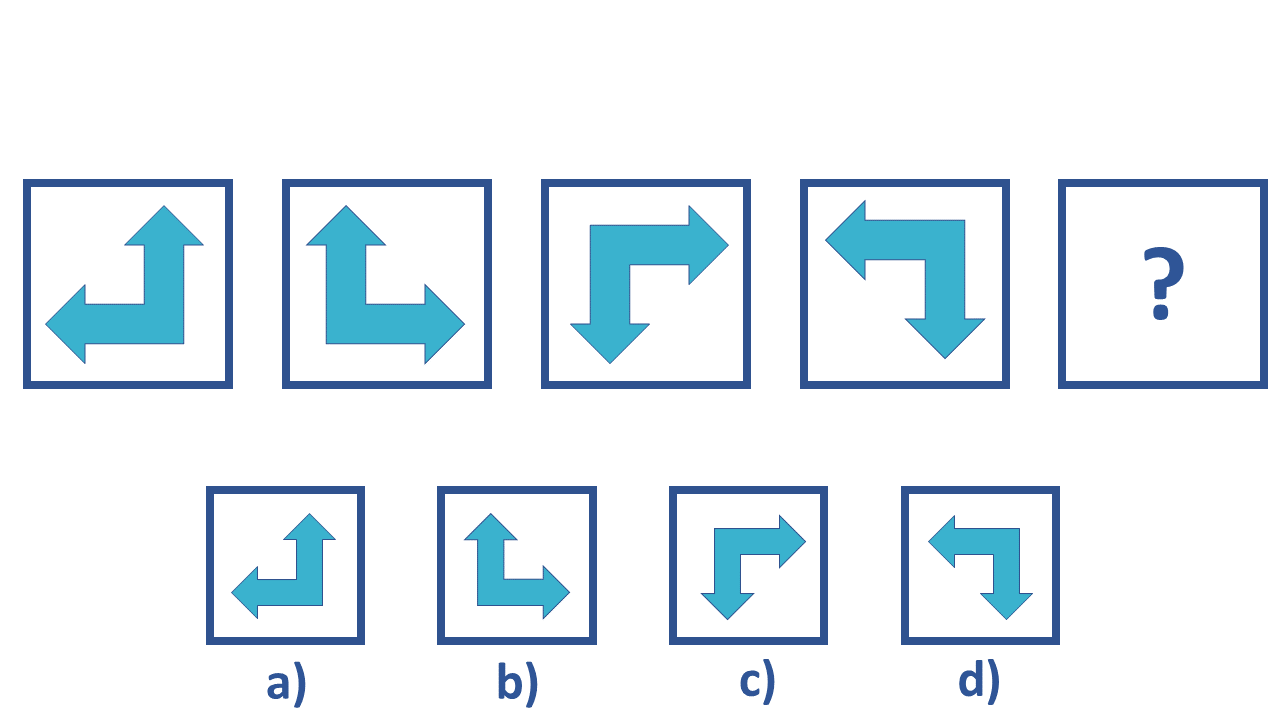
How Is the Swift Executive Aptitude Test Scored?
After the assessment is complete, the recruitment team will receive a breakdown of your results to use as part of their decision-making process.
Your score is marked through each section and is expressed as a total score and as separate subsections too. The results you get are compared against other test takers, to be presented on a Sten scale from 1 to 10.
A Sten score of 10 means that you have performed highly, and you have a higher potential than 99% of test takers.
A Sten of 5 is about average and demonstrates that you have higher potential than 40% of test takers.
A Sten of 1 indicates low performance, and you will have higher potential than 1% of test-takers.
Each company will have their own levels and requirements that must be met to progress to the next round in the interview process, so it is important that you score as highly as you can to give yourself the best chance.
You cannot usually retake a Swift Executive Aptitude Test in the same recruitment round, but you may be able to reapply later and get the opportunity to take it again.
How to Prepare for the Saville Swift Executive Aptitude Test
Step 1. Practice Essential Skills for Each Section
Aside from practicing the test itself, you can actually work on the skills and aptitudes in your everyday life.
Verbal Ability
- Read widely, and assess the information provided in newspapers, journals and books
- Look up the meanings of unfamiliar words and think about synonyms
- Brush up on spelling and grammar rules
- Complete word puzzles like crosswords
Numerical Ability
- Revise school-level mental arithmetic
- Get used to not relying on a calculator for basic operations
- Get familiar with tables, graphs and charts
- Play math-based games
Abstract Ability
- Look for patterns in sequences and series
- Play online logic games and solve puzzles
Step 2. Have the Right Equipment for the Test
For the online test, which is the most usual form, you will not need any special provisions other than a strong and reliable internet connection and a laptop or PC. It is not recommended to take the Swift Executive Aptitude Test on a mobile device.
If you are asked to take the Swift Executive Aptitude Test as an offline test, you will be required to use a pen and pencil, and the timings and number of questions might be different.
These usually take place as part of an assessment center, and you will find out from the recruitment team if this is the type of test you are facing.
Step 3. Take Mock Exams and Practice Papers
One of the hardest parts of taking any aptitude test is unfamiliarity.
Taking practice tests is a great way to not only get used to the type of questions that you will be facing in the real thing but also to get comfortable with the tight time limit and the structure of the questions and answers.
Through mock exams you will be able to highlight any areas that you are weak in so that you can practice and revise more in these – making it more likely that you will score highly throughout the assessment.
Step 4. Understand the Test Format and the Skills Being Assessed
Related to practice papers, if you know what skills are being tested, you can enhance these before the assessment.
A greater understanding of the wider background of the test – and the reason it is being used – can help candidates perform better.
Recruiters want to be sure that the applicants they take further into the assessment actually have the required skills to be successful, and that is what the Swift Executive Aptitude Test is designed for.
Step 5. Prepare for the Test Environment
Another difficulty that some candidates might face in a pre-employment screening test like the Swift Executive Aptitude Test is being in an examination environment.
It is perfectly normal to feel nervous and under pressure in a test, but some preparation can help you to feel more at ease.
Firstly, make sure that you are somewhere where there are no distractions; turn off notifications on your computer and turn off your phone.
Have a bottle of water or something to drink to hand so that you can rehydrate if you need to, and be ready for the time limit, because six minutes per section soon passes.
Step 6. Get Enough Rest Before the Exam
Looking after yourself so that you can perform at your best is really important.
This means getting a good night’s sleep in the run-up to test day, but it also means giving your brain the fuel it needs too – which means healthy meals and lots of water.
The Swift Executive Aptitude Test is a psychometric assessment designed to test the capabilities of candidates who have applied for leadership or executive-level positions.
It is usually an online assessment that is delivered early in the recruitment process, focusing on verbal, numerical and abstract logical abilities.
The content of the questions is high-level but not especially complicated, however your results are compared to other test takers, which could make it more difficult for you to pass.
Practice and familiarity with the test will make a difference for your results and make you feel more confident.
There are many free practice tests available for the Swift Executive Aptitude Test, but for an immersive revision and testing package, the TestHQ Saville Assessments resource is a multi-faceted and in-depth choice.
Different companies use the Swift Executive Aptitude Test, and they tend to only be used for C-Suite, executive, leadership and management positions.
Passing the test is usually mandatory to get through to the next stage in the application process.
The Swift Executive Aptitude Test lasts 18 minutes in total with 24 questions. It is split into three subsections, each with eight questions and a six-minute time limit.
You cannot usually retake the Swift Executive Aptitude Test in the same recruitment round, but you may be able to reapply for the position later and retake the test.
There is no set passing score for the Swift Executive Aptitude Test; it is a bespoke assessment designed for the company that has set the test, so the pass mark will vary depending on the organization.
There is more information on the Swift Executive Aptitude Test available on the Saville Assessments website, including a practice test.
You can also practice for the test and find out all the important info on TestHQ.
If you are taking the test online and at home, you do not need any special equipment and the test itself takes place in an online environment managed by Saville Assessments.
If you are taking the offline test, you might need a pen and paper, but you will be informed about this by the recruitment team.
You can prepare for the Swift Executive Aptitude Test on the Saville Assessments website or through the practice resources at TestHQ.
Usually, after you have taken and passed the Swift Executive Aptitude Test, the next step is to move on to the interview stage of the recruitment process.
The company that utilizes the Swift Executive Aptitude Test pays Saville Assessments for use, but there is no cost to take the assessment for the candidate.
The Swift Executive Aptitude Test asks questions to assess a candidate in the following areas:
- Verbal ability
- Numerical ability
- Abstract ability
Final Thoughts
Many companies across the world use the Swift Executive Aptitude Test as part of the pre-employment screening process for top-level jobs like executives and managers.
If you are facing a Swift Executive Aptitude Test, you need to make sure that you spend some time brushing up on your reading and critical thinking skills, as well as basic math and logical thinking.
Practice makes perfect for this short yet in-depth assessment, and passing it could mean getting to the next stage in your career.

